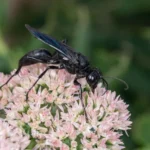Today we’re diving into the buzzing world of wasps. While many of us have had an unpleasant encounter with these flying creatures, it’s fascinating to learn how they work, especially how something as simple as temperature can affect their behavior. So, let’s pull on our learning caps and discover the intriguing relationship between wasps and temperature.
Wasp Biology
When it comes to wasps, it’s crucial to know that they are cold-blooded, just like all insects. This means they don’t have the ability to regulate their body temperature like we humans do. So, how does this tie in with our topic? Well, their body temperature is directly influenced by the temperature of their surroundings.
- Warm Weather Lovers: Wasps love warmth and thrive in sunny climates. In higher temperatures, wasps can be extremely active, buzzing around gardens, parks, and patios in search of food.
- Species Variation: It’s important to note that not all wasps are the same. Some species are more tolerant of heat or cold than others. Some prefer hot, dry climates while others can be found in cooler, humid areas.
Understanding the basic biology of these insects helps us see how they can be so influenced by changes in temperature. So, let’s keep unraveling this mystery in the next sections.
Temperature Thresholds for Wasp Activity
Ever wondered why you don’t see wasps buzzing around on a chilly day? That’s because temperature plays a crucial role in their activity levels.
- The Magic Number: As a general rule, wasps stop flying when temperatures drop below 50 degrees Fahrenheit (10 degrees Celsius). They tend to become sluggish and less active. Their bodies just can’t function properly when it’s too cold!
- Not Just Flight: Temperature doesn’t just affect wasp flight. It can also impact other behaviors such as feeding and nesting. Wasps might struggle to find food in colder weather, which can also make them less active.
Wasps and Cold Weather
So, what happens to wasps when winter rolls in and the temperature plummets?
- Survival Tactics: Wasps have a fascinating way of coping with cold weather. In most species, the worker wasps die off, leaving only the fertilized queens to hibernate and survive the winter.
- Winter Slumber: During this hibernation period, the queens seek shelter in warm and protected spaces like tree barks, attics, or wall cavities. They remain dormant until temperatures rise again, signaling the arrival of spring and the start of a new wasp colony.
With this understanding, you can see how intricately linked wasps are to the temperature of their surroundings. In our final section, we’ll explore some tips on managing wasps in different temperatures.
Managing Wasps in Different Temperatures
Now that we’ve cracked the code on wasp behavior and temperature, let’s explore how we can use this knowledge to manage wasps.
- Warm Weather Wasp Management: During warmer months, when wasps are most active, be mindful of open food and drinks which can attract them. Seal trash bins tightly and check for nests regularly around your home.
- Cold Weather Considerations: In colder months, remember that queen wasps could be hibernating in sheltered areas around your home. If you find a dormant wasp, it’s best to leave it undisturbed. They generally won’t cause a problem and will leave when spring arrives.
Conclusion
And there you have it! A journey into the buzzing world of wasps and their relationship with temperature. From understanding their biology, discovering the temperature thresholds for their activity, to managing wasps in different temperatures, we’ve covered it all. Remember, understanding these creatures is the key to coexisting with them. After all, wasps play an important role in our ecosystem, and learning about them can help us appreciate their place in the natural world. So, next time you see a wasp, remember, they’re just another fascinating part of nature doing their best to survive, just like us!


